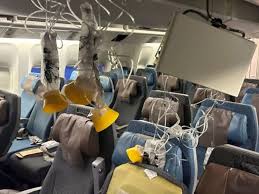Injured passengers on a turbulent Singapore Airlines flight receive compensation. Discover the details of the incident, the airline’s response, and what passengers can expect in terms of recovery and compensation.
There’s nothing like a smooth flight to set your mind at ease, right? But what happens when the unexpected occurs and passengers find themselves in a nail-biting situation? This was the unfortunate reality for passengers on a recent Singapore Airlines flight that hit severe turbulence, resulting in injuries and a wave of concern among travelers. Thankfully, Singapore Airlines has stepped up, offering compensation to those affected. Let’s dive into the details of this turbulent event and what passengers can expect moving forward.
The Turbulence Incident: What Happened?
An Unexpected Turn of Events
It was just another day in the sky for Singapore Airlines flight SQ318, en route from Singapore to London. With a seasoned crew and state-of-the-art aircraft, passengers had every reason to anticipate a seamless journey. However, mid-flight, the plane encountered severe turbulence, jolting everyone out of their seats and into a state of alarm.
Injuries on Board
While turbulence is a common occurrence in aviation, this particular incident was far from ordinary. Several passengers suffered injuries ranging from minor bumps and bruises to more serious conditions that required immediate medical attention upon landing. The unexpected turbulence resulted in:
- Passengers hitting their heads against overhead compartments.
- Hot beverages spilling and causing burns.
- Loose items becoming dangerous projectiles within the cabin.
Singapore Airlines’ Response
Swift and Compassionate Actions
In the wake of this unsettling experience, Singapore Airlines wasted no time in addressing the needs of the injured passengers. Demonstrating their commitment to customer care, the airline promptly issued a statement expressing regret over the incident and ensuring that those affected would be well taken care of.
Compensation Details
Singapore Airlines has announced a comprehensive compensation package for the injured passengers, which includes:
- Medical Expenses: Full coverage of medical treatments required due to the injuries sustained.
- Financial Compensation: Additional financial compensation based on the severity of the injuries and the inconvenience caused.
- Future Travel Vouchers: Vouchers for future flights as a gesture of goodwill and assurance of better travel experiences ahead.
Passenger Reactions
A Mix of Emotions
Unsurprisingly, reactions among the passengers varied widely. While some were grateful for the quick response and compensation offered by the airline, others were understandably shaken and concerned about future flights.
Voices from the Cabin
Several passengers shared their experiences and thoughts:
- Emma Johnson: “I was terrified when the plane started shaking violently. I’m thankful for the prompt medical assistance and the compensation, but it was a harrowing experience.”
- David Lee: “The turbulence was really bad, but Singapore Airlines handled it well. The compensation is fair, and I’m glad they’re taking care of us.”
- Sophia Martinez: “It was the worst flight I’ve ever had. I appreciate the compensation, but it’s going to take a while before I feel comfortable flying again.”
Understanding Turbulence: Why Does It Happen?
The Science Behind the Bumps
Turbulence is essentially a sudden change in airflow, often caused by weather phenomena such as storms, jet streams, or mountain waves. While it can be alarming, it’s usually not dangerous. Pilots are trained to handle turbulence, and modern aircraft are built to withstand it.
Preventative Measures
While turbulence can’t always be avoided, there are measures that airlines and passengers can take to minimize its impact:
- Flight Planning: Airlines use advanced weather forecasting tools to plan routes that avoid known turbulence zones.
- Seatbelt Signs: Passengers are advised to keep their seatbelts fastened whenever seated to reduce the risk of injury.
- Cabin Crew Training: Crew members are trained to manage turbulence and ensure passenger safety during unexpected bumps.
FAQs
How common is severe turbulence?
Severe turbulence is relatively rare. Most turbulence experienced during flights is mild to moderate and doesn’t pose significant risks.
What should I do if I experience turbulence during a flight?
Stay calm, remain seated with your seatbelt fastened, and follow the instructions of the cabin crew. Avoid walking around the cabin during turbulence.
Will I be compensated for turbulence-related injuries on other airlines?
Compensation policies vary by airline. It’s important to review the terms and conditions of your ticket and contact the airline directly if you experience an issue.
Can turbulence cause a plane to crash?
While turbulence can be unsettling, modern aircraft are designed to handle it. Severe turbulence is extremely unlikely to cause a plane crash.
Moving Forward: Ensuring Safer Skies

Lessons Learned
Incidents like this serve as a reminder of the unpredictable nature of air travel. Airlines continually review and improve their safety protocols to protect passengers and crew.
Technological Advances
Advancements in technology, such as improved weather forecasting and real-time turbulence detection systems, are helping pilots navigate more safely and reduce the occurrence of unexpected turbulence.
Passenger Preparedness
Passengers can also play a role in ensuring their safety by following airline safety guidelines, such as keeping seatbelts fastened and securing loose items during the flight.
Conclusion
The recent incident on Singapore Airlines flight SQ318 underscores the importance of preparedness and swift response in ensuring passenger safety and satisfaction. While the turbulence was a frightening experience for those on board, the airline’s proactive approach in offering compensation and medical support demonstrates their commitment to passenger care.
As air travel continues to be a preferred mode of transportation for millions, both airlines and passengers must remain vigilant and informed about safety measures. With advancements in technology and a collective effort towards safer skies, we can look forward to smoother journeys ahead, even when the unexpected occurs.
Whether you’re a frequent flyer or an occasional traveler, knowing how to stay safe and understanding your rights can make all the difference in navigating the bumps and turbulence of air travel. Safe travels!
Also Read about A to Z Sportz




